新丝绸之路
2018-05-10詹姆斯希契莫夫汤姆斯图尔特史密斯
(英)詹姆斯·希契莫夫 (英)汤姆·斯图尔特-史密斯
我们此次设计的灵感源自丝绸之路,由东向西穿过中国干燥的中部草原。在整体布局上我们采用林地包围林间花草甸的形式,以此营造一种相对独立于世园会园区内其他展园的感觉,使展园内外的视觉语言互不干扰。访客须经过由林地构成的花园外壳才能逐渐接近,并最终进入花园内部核心,这样的体验过程会给内部核心花园一种更强的存在感和抵达感。 我们认为,在大型世园会的规模下,能不时让访客感到别有洞天、有近距离接触的体验是很重要的,这一要求已在我们的提案中得到解决。
被树林包围的中央开阔区域是一片特色干草原花草甸,远端是一个大型的结构,既像帐篷又像大树,俯瞰整个园内空间。 这个帐篷将由竹子制成,为花园提供阴凉的休息区域。
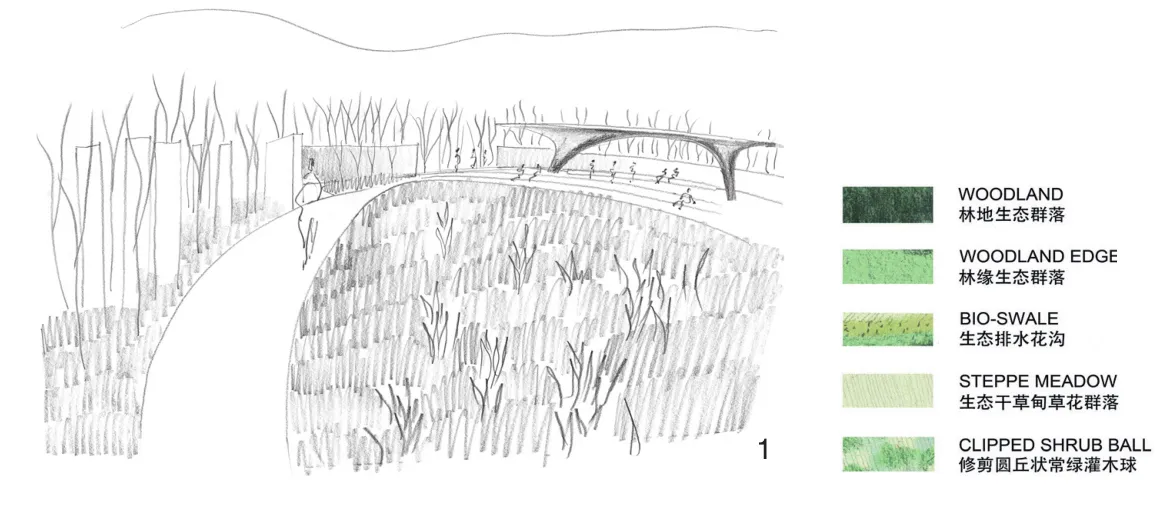
1 人视手绘草图Hand Sketch Ground View
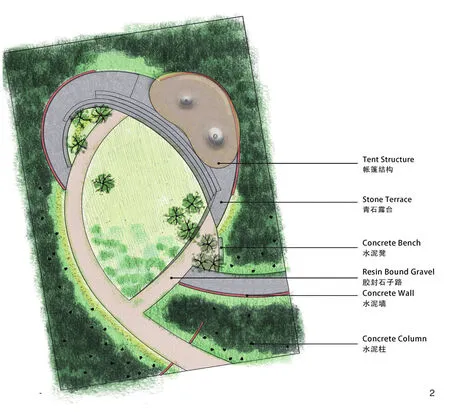
2 平面图Main Plan keys

3 平面功能分区Plan Function Zones
弯曲的混凝土墙半围合心形的花园内部。墙壁不仅隔离了园外空间,并为放置在其前面的长弯曲座椅隔离出供游客观赏园景的空间。弯曲的墙壁随着时间变化将在花园内呈现光怪陆离的阴影图案。在花园的入口处,还会有许多精细加工的柱子。从某些角度望去,这些柱子似乎是随机安排的,从其他角度看,它们将会是规整对齐的。我们希望通过这些柱子使得人为构筑物在排布与制作上更为精细准确,并与植被的自然形态与质感形成非常强烈的对比。
花园的外围部分在视觉上将更为安静,宛如在真的树林里一样。亮点是植物间微妙的纹理对比,以及墙壁、柱子、路径等构筑物和植被之间的对比。中心区域的干草甸草花群落将是没有任何构筑物的开阔区域。相比林地,草花群落将有更多色彩及干草甸的特质。干草甸草花群落的边缘会散布一些林地边缘的灌木及高大的草本植物,表明2种栖息地相互融合,并不完全分开。
我们看到花园的主要入口路径约为4m宽,由固定的砾石或小方石组成。 随着道路分叉,越变越窄的同时也给游客提供了更多游览花园的路径选择。这条路径在材质上与其他路径和帐篷所在的露台形成对比。其余路径和露台由另一种石头制成,比墙壁的混凝土颜色暗一些。 我们看到的弯曲座椅是由与墙壁相同的预制混凝土制成。
我们设想用原竹建造这个帐篷结构,并希望能够通过巧妙设计避免使用任何钢构件。这个帐篷基于这样一个立意:人们相遇聚集的地方,也是无机的人工构筑物和有机的植被相遇、融合的地方。所以帐篷在形态和材料上为不规则的有机体,同时又被精确地设计建造,以此表现有机和无机在花园中可调合地互依共存。这个结构在草原上还起着遮阳作用。它的大型屋面将用于雨水收集。我们正在考虑这种可能性:收集的雨水被过滤和灭菌,在炎热的夏季以水雾形式周期性地从树冠周围喷出,给游客降温。帐篷底下及周围的露台比草甸地面高约450mm,从露台通过台阶或舒缓的坡道可抵达花园的主要部分。露台和草甸间有3级很宽的台阶,暗示这并非让游客走进草甸,而是引导大家自由坐在台阶上,从近处欣赏干草甸草花的区域。
我们试图展示如何在人为改造自然景观后,通过重塑和培育,使新的景观能满足人与自然和谐共存。 人为干预的规模越大,越需要我们加强对受影响地区景观特征的关注。 所以重点在于,如何将植物种得浑然天成,没有人工的痕迹。 要做到这一点难度是相当大的。
花园的植被是基于植物群落的概念设计的。 这些设计反映了植物在自然栖息环境的组合方式。在我们的花园里有5个专门营造的栖息环境类型:林地冠层、耐阴且耐旱的林下草本植物群落、耐阴/耐阳林地边缘草本植物群落、可承受季节性干湿变化的排水洼地植物群落、全阳条件下耐旱干草甸植物群落。经过精心选择的植物列表包含能适应以上各种特定栖息环境的物种。 一些能适应不同光照及土壤干湿条件的植物将会出现在多个设计的群落中,使各个群落在视觉上相互呼应,并使整个花园的景观空间有连续感。

4 组合断面Build up section

5 主入口Main entrance
林地冠层的密植结构使得林地下层变得较荫蔽且干燥。耐阴且耐旱的林下草本植物群落的种植意图是将林下空间设计得充满趣味:常绿的基底包含质地丰富的各类草本及蕨类植物,季节性隐现的球根植物为这一群落带来跳跃的色彩。该群落将由一个低矮的横向延伸的基底层(植株高度不高于150mm),一个高度在300mm以下的中层草本层,和一个偶尔出现且体量略大的结构体态植物层(典型的林地苔草和蕨类植物)组成。耐阴/耐阳林地林缘生态景观群落中使用的物种均具有一定的耐阴和耐阳光直射的能力。面向西侧的林缘植物需要具有耐受西晒的能力,而面向北侧的林缘植物将会更多的考虑耐阴物种。这些植物将会大量以个体或组团形式无规律的自由种植,并在整个林缘空间中重复出现。在林缘群落种植中,物种将被分为3个层次:低矮的半球形的植物作为基底层,其作用是覆盖地面,并大多在春季进入花期展示;中等高度的植物(密度较低)以及少量在夏末进入盛花期展示的高度较高、体量较大的植物,以保证景观视觉通透性。
我们的花园还将展示“海绵城市”的设计原则是如何应用在花园设计中。我们将把落在坚硬的地面和建筑物上的雨水引导到林地中的雨水花园和生态花沟里,用完全没有地下管网的方式解决雨洪问题。这些雨水花园要求植物能够忍受暂时的潮湿,及随后长时间的干燥,并能在夏秋呈现良好的景观效果。
从公安局被保释回家的关小美,挺着大肚子,在父母面前失声痛哭。关云飞追悔莫及,他唉声叹气地说:“女儿,都怪爸爸太专行独断,是我害了你们啊!其实,爸爸对你也是一片苦心啊,我之所以处处给郭启明设置‘障碍’,是想让他知难而退,没想到他竟然做出这种事来。其实他把32万首付房款的银行卡递到我手上时候,我已经开始从内心接纳这个小伙子了。早知如此,我还不如让你们顺顺当当结婚……”
最后我们还想借此展园表达,中国,作为一个地跨东西的大国,必将以新的贸易路线、交通运输方式和各类交流,使各国变得更近,使世界变得更小。
(编辑/张雯娟)
项目设计:詹姆斯·希契莫夫,汤姆·斯图尔特-史密斯,杭烨,吴嘉骥,曹经宇
翻译:杭烨,吴嘉骥
The garden for the Beijing Expo 2019 is inspired by the idea of the Silk Route, crossing the dry central steppes of China from east to west.The garden takes the form of a glade surrounded by woodland. We have done this in part to create a sense of the garden being a bit separate from the rest of the expo and so that the visual language of our garden is isolated from what is going on elsewhere. We approach the heart of the garden thorough an outer shell of woodland as this will give the garden a stronger sense of presence and a feeling of arrival. We also think it is important within the scale of a large Expo to create moments of enclosure and comparative intimacy and our proposal will achieve this.
The central glade in the garden has the characteristic planting of the steppe and at the end of it is a large structure, part tent and part tree that overlooks the space. This will be made of bamboo and will provide shade in the garden and a place to rest.
The garden takes vegetation that is inspired and informed by natural plant associations and contrasts this with sharply detailed hard surfaces and structures. In plan the key element of the design is a pair of overlapping loops, reflecting the diverse branches of the Silk Route. The long curving paths cut through the woodland area into the heart of the garden in the same way as a large road or railway might, reflecting the idea that the new railway is to become, in effect, the new Silk Route. As it moves it gives an ever changing view of the landscape, but it remains separate from it so the land is respected and can recover its full beauty and ecological potential.
Curved concrete walls serve to partially enclose an inner core, or heart of the garden, which is actually formed in the shape of a heart. The walls give protection from the outside and provide shelter for long curving seats placed in front of them from where visitors can look across the space. The curving walls will give a constantly changing pattern of light and shade within the garden. In the entrance area of the garden there will also be a number of finely detailed pillars. From certain aspects these seem randomly arranged and from other aspects they will be aligned. The intention is that the construction is very precise and makes a very strong contrast with the natural quality of the planting.
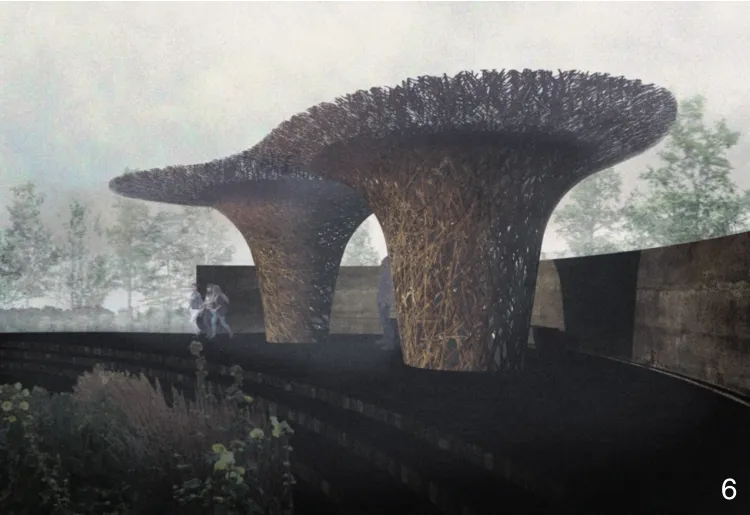
6 竹结构Bamboo structure
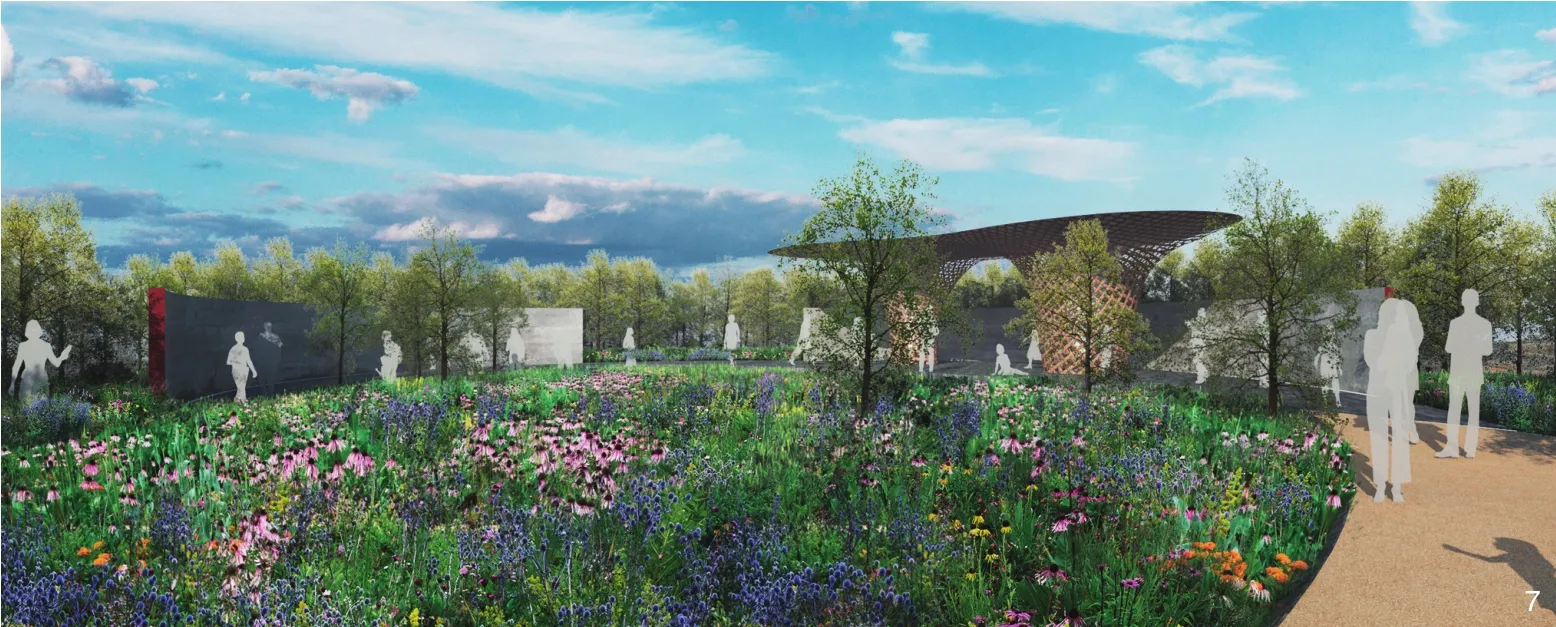
7 北向人视图Ground view looking north
The outer part of the garden will be more visually quiet, as you would expect in a woodland.The interest is in the subtle and contrasting textures of the plants, and the contrast between the planting and the built structures, the paths the walls and the pillars. The steppe will be open area without any construction within it. It will be more colourful than the woodland and with a higher component of wild grasses, such a characteristic species of the steppe. There will be some shrubs from the woodland scattered along the edges of it to show that the two types of habitat blend in to one another and are not entirely separate.
We see the main entrance path to the garden being about 4m wide and made of a sealed gravel or stone setts. It gets narrower as other paths join it giving more options to move around the garden.This path contrasts with the other paths and the terrace around the shelter which would be made from a different stone, slightly darker than the concrete of the walls. The curving stone seats we see as being made of pre-cast concrete of the same composition as the walls.
The shelter/tent structure we see as being constructed of bamboo. We hope to be able to engineer this so that we can avoid building it with any steel sub-frame. We like the idea that the place where people meet is also the place where the constructed, inorganic part of the garden and the planted, organic part of the garden come together.The structure will have an organic quality but will be precisely constructed so it illustrates have the division between the organic and inorganic shown in the garden can be reconciled. We see the structure also acting as a large sun shade in the Steppe. The large roof area will be used to collect rain water and we are looking at the possibility that this could be filtered and sterilised and used to emit a periodic mist from the canopy to cool down visitors in the very hot summer months.The terrace that surrounds the structure is raised up about 450mm from the steppe and is accessed from the main part of the garden either by steps or a shallow, accessible ramp. There are three shallow steps leading down to the steppe. This is not to invite people to walk on the planting but to enable people to sit on the steps and take a close look at the planting.
The garden gives a message about how it is possible to make engineering interventions in a natural landscape which can then be restored and nurtured so that man and nature can co-exist in harmony. As the scale of these interventions we make become ever larger, so we need to be increasingly mindful of how we care for the landscape and character of those places affected.So it is important for us that the planting will have a quality that looks as if it has almost been created by nature and not man. This is of course one of the most difficult things to achieve.
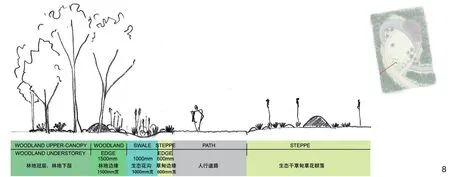
8 植物群落种植设计:跨越道路两边的干草甸草花群落种植,将花园的核心区与林地区有机联系The nature of plantings: the steppe “jumps the path” to connect both sides
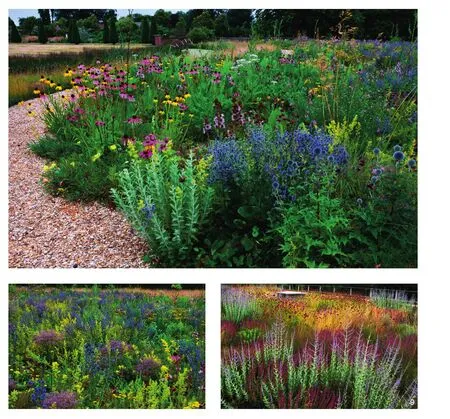
9 全阳光照条件下耐旱的生态干草甸草花群落示意图A schematic diagram of the steppe under the condition of full sunlight
The vegetation for the garden is based upon the idea of designed plant communities.The design of these reflects the organization of plants in natural habitats. Within our garden there are essentially five distinctive designed habitats:woodland canopy layer, shade and drought tolerant under-canopy of herbaceous plants, shade/sun tolerant edge herbaceous vegetation, drainage swale vegetation tolerant of oscillating wet dry conditions, drought tolerant steppe vegetation for use in full sun. The planting palette for these involves plants that tolerate the speci fic conditions found in these habitats. Some plants that are very tolerant of a wide range of conditions will occur in more than one designed habitat and are used to provide visual connections and a sense of continuity across the garden spaces.
Because of the close tree placement, it will be shady and dry beneath the woodland. The aim of the Shade and drought tolerant under-canopy of herbaceous planting here will be to provide a green cover of interesting textured and in some cases evergreen foliage, with seasonal displays of flowers in spring and autumn. There will be a low spreading sheet layer (up to 150mm tall), a more bump like layer coming out of this (up to approximately 300mm tall),and then some taller emergent (mainly woodland sedges and ferns) as occasional incidents coming out of these ground covering layers. The species used in shade/sun tolerant edge herbaceous planting community have some capacity to tolerate both shade and sun. On west facing edges species with greater tolerance of afternoon sun will be more common,on north facing edges species used will be drawn from more shade tolerant species. These plantings will largely involved random mixtures of individual plants that are repeated across the woodland edge spaces to be planted. Within these mixes species will be organised in three layers; a ground layer of species with low clumping or dome like form whose role is to cover the ground and provide floral interest mainly in spring, an intermediate layer that arises out of the base layer (at low density), and a taller emergent layer,many species of which flower in later summer. These latter plants are present at only low densities to create a see through effect.
We will also show how the principles of the“Sponge City” can be applied to horticultural planting in garden. We will take rain that falls on hard surfaces and buildings and drain it into swales within the woodland, rather than piping it elsewhere to contribute to local flooding. These rain gardens require plants that can tolerate temporary wetness and then long periods of dry-ness and yet still look good into late summer autumn.
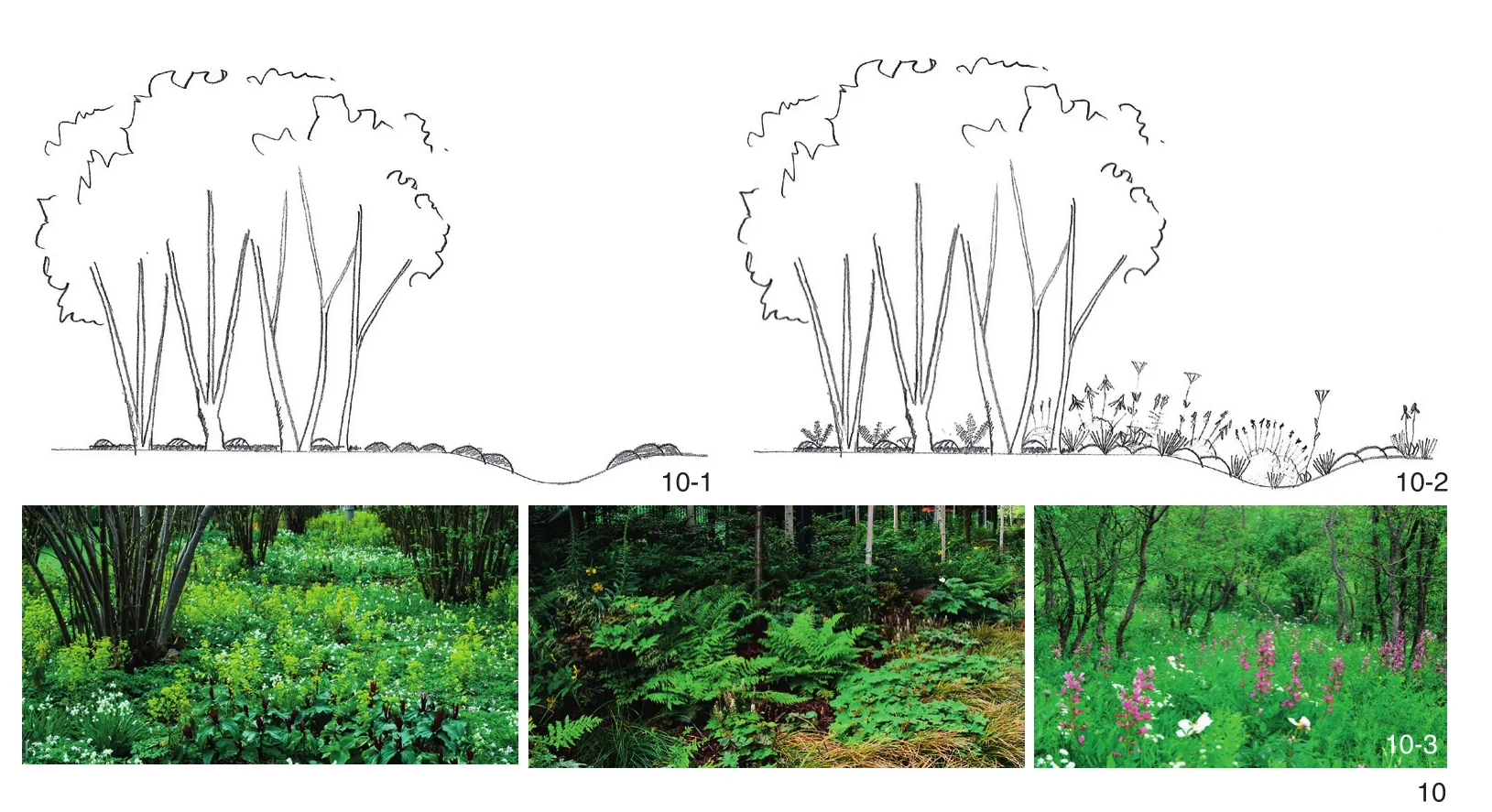
10-1 基础种植层Base layer10-2 多层次结构营造不同空间感受Multi-layers10-3示意图Schematic diagram10 “林地—林缘—生态花沟—生态干草甸草花群落”景观结构对比示意图Woodland to woodland edge to swale to steppe edge structure comparison
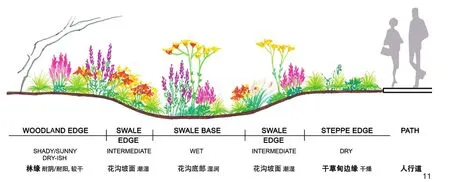
11 可承受季节性干湿变化的生态排水花沟植物群落Drainage swale vegetation tolerant of oscillating wet dry conditions
The garden also has a message about the signi ficance of China as a nation that spans from East to West and how new trade routes and methods of transport and communication are forever making the world a more connected place.
